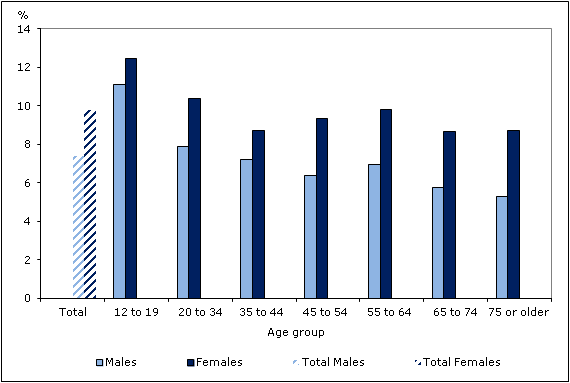Asthma, 2011
Archived Content
Information identified as archived is provided for reference, research or recordkeeping purposes. It is not subject to the Government of Canada Web Standards and has not been altered or updated since it was archived. Please "contact us" to request a format other than those available.

Asthma is a chronic inflammatory disorder of the airways that causes coughing, shortness of breath, chest tightness and wheezing. Quality of life can be affected not only by asthma attacks, but also by absences from work and limitations in other activities1.
In 2011, 8.6% of Canadians aged 12 and older reported that they had been diagnosed with asthma by a health professional. This rate did not change significantly from 2001 to 2011.
Throughout this period, females were more likely than males to report that they had asthma. In 2011, the rate was 9.8% for females compared with 7.4% for males (Chart 1).
Chart 1
Percentage diagnosed with asthma, by sex, household population aged 12 or older, Canada, 2001 to 2011

Source: Canadian Community Health Survey, 2001, 2003, 2005, 2007, 2008, 2009, 2010, 2011.
Females were more likely than males to have asthma in all age groups, with the exception of those aged 12 to 19, and those aged 35 to 44 where there was no significant difference between the sexes (Chart 2).
Among both males and females, the youngest age group had the highest rate of asthma.
Chart 2
Percentage diagnosed with asthma, by age group and sex, household population aged 12 or older, Canada, 2011

Source: Canadian Community Health Survey, 2011.
The proportion of residents who reported having asthma was lower than the national average in Ontario (7.8%) while the province of Quebec (9.5%) had a higher proportion of residents who reported having asthma compared to the national average (8.6%). In the other provinces and territories2, the rates were about the same as the national average.
End note
- Chen, Yue, Helen Johansen, Satha Thillaiampalam and Christie Sambell, 2005, "Asthma." Health Reports. Vol. 16, no. 2. March. Statistics Canada Catalogue no. 82-003. page 43. /studies-etudes/82-003/archive/2005/7790-eng.pdf (accessed May 10, 2010).
- Note that the rates for Yukon and Northwest Territories had coefficients of variation between 16.5% and 33.3%; interpret with caution. The rate for Nunavut had a coefficient of variation greater than 33.3%; this data is too unreliable to be published.
Reference
Chen, Yue, Helen Johansen, Satha Thillaiampalam and Christie Sambell, 2005, "Asthma." Health Reports. Vol. 16, no. 2. March. Statistics Canada Catalogue no. 82-003. page 43–46. /studies-etudes/82-003/archive/2005/7790-eng.pdf (accessed May 10, 2010).
Data
Additional data from the Canadian Community Health Survey are available from CANSIM table 105–0501.
- Date modified:
